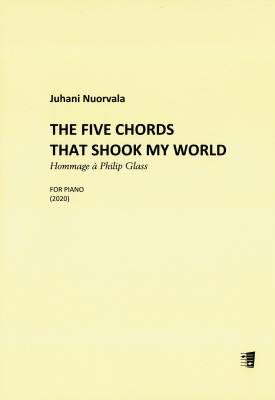The Five Chords That Shook My World - Piano — Hommage à Philip Glass
Nuorvala, JuhaniProduct information
| Title: | The Five Chords That Shook My World - Piano — Hommage à Philip Glass | ||
| Authors: | Nuorvala, Juhani (Composer) | ||
| Product number: | 9790550116764 | ||
| Product form: | Sheet music | ||
| Availability: | Delivery in 7-16 days | ||
| Price per piece: | 14,40 € (11,47 € vat 0 %) | ||
|
|||
| Publisher: | Fennica Gehrman |
| Edition: | 2020 |
| Publication year: | 2020 |
| Language: | English |
| Pages: | 9 |
| Product family: | Piano |
| Finnish library classification: | 78.61 Piano |
| Key words: | piano, minimalismi |
Juhani Nuorvala (b. 1961) wrote The Five Chords That Shook My World (2020) for pianist Nicolas Horvath's Hommage à Glass project and it is dedicated to him. It's a fantasy meditation on the Train/Spaceship chords in Einstein, that repeating five-chord progression (Fm - Db - A - B7 - E) about which the composer has said that there's something strange, because it never fails to lift the audience to its feet. The duration of the piece is c. 6'30'', and it was premiered by Emil Holmström at RUSK festival (Pietarsaari, Finland) 20th November 2020.
A notable variety of influences - microtonality, American minimalism, New Romanticism, popular music, techno - has been regarded as a special feature of Nuorvala's idiom. Despite this he is not a collage artist; instead he has blended various ingredients to create a mode of expression entirely his own. Nuorvala's works are often marked with frenzied rhythmic drive. He makes music using elements and materials that both the mind and the body respond to. He finds these elements not only in old or new classical music but in various forms of urban popular music, such as the electronic music of modern dance clubs.
A notable variety of influences - microtonality, American minimalism, New Romanticism, popular music, techno - has been regarded as a special feature of Nuorvala's idiom. Despite this he is not a collage artist; instead he has blended various ingredients to create a mode of expression entirely his own. Nuorvala's works are often marked with frenzied rhythmic drive. He makes music using elements and materials that both the mind and the body respond to. He finds these elements not only in old or new classical music but in various forms of urban popular music, such as the electronic music of modern dance clubs.




